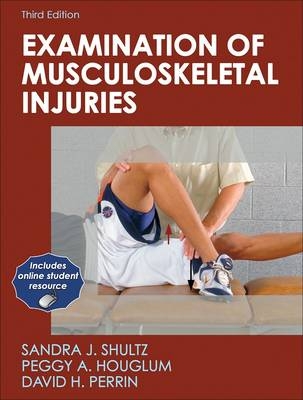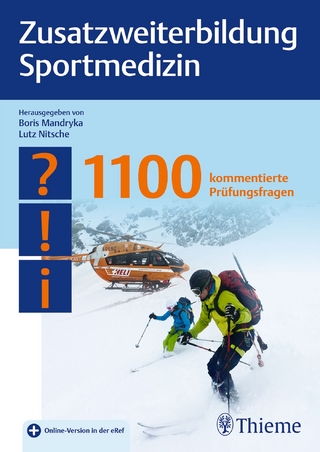
Examination of Musculoskeletal Injuries
Human Kinetics (Verlag)
978-0-7360-7622-7 (ISBN)
- Titel erscheint in neuer Auflage
- Artikel merken
The third edition of Examination of Musculoskeletal Injuries assists both current and future rehabilitation professionals in recognizing musculoskeletal injuries, performing musculoskeletal examinations of athletic injuries, and evaluating if and when to refer clients to a physician's care. The text will help students master the skills required for completing the Board of Certification examination for athletic trainers by thoroughly covering all the content in this area of specialization set forth in the National Athletic Trainers' Association (NATA) Athletic Training Educational Competencies.
Completely updated and expanded, the third edition of Examination of Musculoskeletal Injuries incorporates an increased emphasis on clinical decision making, problem solving, and integration of skill application. Revised chapter-opening scenarios present open-ended real-life situations that initiate discussion of the complexity of athletic injury examination. Review and critical thinking questions have been updated to assist readers in developing their clinical decision-making and problem-solving skills. Laboratory activities have been added to aid students with hands-on practical application of the material. Data tables that report the sensitivity and specificity of special tests strengthen the evidence-based selection of those tests as they are used in the examination procedure. Also, revised information in the functional anatomy and injury recognition sections form a more cohesive connection with the musculoskeletal examination process.
Examination of Musculoskeletal Injuries begins with comprehensive coverage of foundational assessment tools, which prepare readers to understand and apply the joint-specific evaluation techniques that follow. Next, recognition and examination of injuries and conditions specific to each body region are addressed. Real-life scenarios precede the discussion of each examination strategy. The final section of the text addresses general medical conditions normally found in active persons. Because examinations of these conditions usually are the physician's responsibility and require the use of diagnostic tests for identification, the text prepares readers to make appropriate referrals based on patients' histories, signs and symptoms, and their own observations. This unique text categorizes injury examination strategies into on-site, acute, and clinical protocols, allowing rehabilitation professionals and students to focus their evaluation skills on emergent, nonemergent, and postacute conditions.
Examination of Musculoskeletal Injuries also includes learning elements and supplemental materials for students, professionals, and instructors:
-Pedagogical aids such as chapter objectives and summaries, key terms, review and critical thinking questions, a glossary, references, and bibliographical material assist in learning and retaining crucial material.
-More than 120 lab activities for each chapter assist students in building their clinical decision-making and problem-solving skills.
-Special warning boxes and reminder boxes highlight techniques and knowledge crucial for avoiding further injury, permanent disability, or even death.
-Over 500 photographs and nearly 300 illustrations and tables enhance comprehension of content.
-Checklists provide the framework for developing a systematic approach to injury examination in various settings.
Examination of Musculoskeletal Injuries, Third Edition, features an online student resource (OSR) that will help students thoroughly understand the material. The OSR includes printable examination checklists; tables detailing range of motion, neurological conditions, and strength; and superb full-color photographs of skin ailments that will enhance students' ability to identify skin disorders. For instructors, the text includes a full range of ancillaries including an image bank, instructor guide, and test bank.
Human Kinetics' Athletic Training Education Series contains six outstanding textbooks, each with its own supplemental instructional resources. Featuring the work of respected athletic training authorities, the series parallels and expounds on the content areas established by the National Athletic Trainers' Association (NATA) Education Council.
Sandra J. Shultz, PhD, ATC, CSCS, FNATA, is an associate professor and director of graduate study at the University of North Carolina at Greensboro. As a certified athletic trainer since 1984, Shultz has a broad clinical perspective having worked with athletes at the high school, collegiate, Olympic, and international levels. Before coming to the University of North Carolina at Greensboro, Shultz taught and conducted clinical research in the sports medicine and athletic training program at the University of Virginia. She also served as associate director of athletic training and rehabilitative services at the University of California at Los Angeles, where two of her primary responsibilities were the direct health care of student-athletes and the education of athletic training students. Shultz is a member of the National Athletic Trainers' Association (NATA), the American College of Sports Medicine (ACSM), the National Strength and Conditioning Association (NSCA), and the Orthopaedic Research Society (ORS). She currently serves as a member of the NATA Foundation Research Committee and Fellows Award Committee and is a section editor for the Journal of Athletic Training. Previously she served on the NATA's Entry-Level Education Committee, Pronouncements Committee, Convention Educational Program Committee, and Appropriate Medical Coverage for Intercollegiate Athletics Task Force. She was also the site visitor for the Joint Review Committee on Educational Programs in Athletic Training (JRC-AT). As a researcher, Shultz focuses on the study of risk factors for anterior cruciate ligament injury in female athletes and has received grant funding from the National Federation of State High School Associations (NFHS), the NATA Research and Education Foundation, and the National Institutes of Health. She is the primary author of the NFHS Sports Medicine Handbook and the NATA Appropriate Medical Care for Intercollegiate Athletics. Shultz received the Most Distinguished Athletic Trainer Award from the NATA in 2005, and the Freddie H. Fu, MD, New Investigator Award from the NATA Foundation in 2003. She was the recipient of the Kenneth L. Knight Award for Outstanding Research Manuscript from the Journal of Athletic Training in 2001. Shultz enjoys running, reading, and traveling. She resides in Greensboro. Peggy A. Houglum, PhD, ATC, PT, is an associate professor at the Rangos School of Health Sciences at Duquesne University in Pittsburgh. She has nearly 40 years of experience providing patient and athlete care in a variety of settings, including athletic training facilities, sports medicine clinics, rehabilitation hospitals, acute care hospitals, burn care facilities, workers' compensation clinics, and extended care facilities. She has also served as an athletic trainer with the United States Olympic Sports Festivals, Olympic Games, and World University Games. Houglum's extensive background as a certified athletic trainer, physical therapist, clinical and classroom educator, and program director gives her a unique perspective on the appropriate use of therapeutic exercise techniques in rehabilitation programs for treatment of athletic injuries. In 1991, Houglum created the NATA's first formal continuing education programming. Since that time Houglum has served as chair of the NATA Continuing Education Committee and as a member of the organization's Education Council and the Council on Employment. In 2002, she was named to the NATA Hall of Fame, the association's highest award, and received NATA's Most Distinguished Athletic Trainer Award in 1996. Houglum is a member of the American Physical Therapy Association's Sports Medicine Section and CEPAT. She is also a member of NATA and serves on the NATA Board of Certification Role Delineation #6 Committee. Houglum is also associate editor for Sports Rehabilitation and clinical applications editor of the Journal of Athletic Training. In her free time, Houglum enjoys spending time with family, reading, and painting. She resides in Gibsonia, Pennsylvania. David H. Perrin, PhD, ATC, is Provost and Vice Chancellor for Academic Affairs of the School of Health and Human Performance and a professor at the University of North Carolina at Greensboro. For 13 years, Perrin was a member of the NATA Professional Education Committee, helping to write the guidelines for accreditation of both undergraduate and graduate athletic training education programs. For 15 years, he directed the graduate programs in athletic training and sports medicine in the Curry School of Education at the University of Virginia. He was editor in chief of the Journal of Athletic Training from 1996 to 2004 and was the founding editor of the Journal of Sport Rehabilitation. He is author of Isokinetic Exercise and Assessment and Athletic Taping and Bracing, editor of the third edition of The Injured Athlete, and coauthor of Research Methods in Athletic Training. Perrin's research interests include injury risk factors of the anterior cruciate ligament in female athletes. His awards from the National Athletic Trainers' Association include the Sayers "Bud" Miller Distinguished Educator Award, the Most Distinguished Athletic Trainer Award, the William G. Clancy, Jr., MD, Medal for Distinguished Athletic Training Research, and induction into the NATA Hall of Fame. He is a fellow of the American College of Sports Medicine and a fellow of the American Academy of Kinesiology and Physical Education. In his free time, Perrin enjoys traveling, exercising, and vacationing at his lake cottage in Vermont.
Part I. Principles of ExaminationChapter 1. Anatomical Nomenclature and Injury ClassificationsAnatomical Reference TerminologyPhysical Maturity ClassificationsInjury ClassificationsClosed (Unexposed) WoundsOpen (Exposed) WoundsSummaryLearning AidsChapter 2. Principles of Examination: An OverviewProper Use of TerminologyExamination ComponentsDocumenting the ExaminationSummaryLearning AidsChapter 3. Taking a HistoryInformation to SeekSituation-Specific History and Depth of InquirySummaryLearning AidsChapter 4. ObservationSystem of Observational ExaminationDetails of Specific ObservationSummaryLearning AidsChapter 5. PalpationGeneral PrinciplesStructures to PalpatePalpation StrategiesSummaryLearning AidsChapter 6. Examination of MotionGoals and PurposesNormal Range of MotionPrerequisites for Successful ROM ExaminationMeasuring Range of MotionAccessory Movement ExaminationSpecial Tests: Ligament and Capsule Stress TestsSummaryLearning AidsChapter 7. Examination of StrengthMuscle ContractionGoals and PurposesManual Strength ExaminationInstrumented Strength ExaminationSummaryLearning AidsChapter 8. Examination of Neurological StatusFunctional NeuroanatomyGeneral Principles of the Neurological ExamRegion-Specific Neurological ExaminationSummaryLearning AidsChapter 9. Examination of Cardiovascular and Respiratory StatusFunctional Anatomy and PhysiologyExamination of Cardiovascular and Respiratory StatusCardiovascular CompromiseSummaryLearning AidsChapter 10. Putting It All Together: General Examination StrategiesOn-Site ExaminationAcute ExaminationClinical ExaminationSummaryLearning AidsPart II. Region-Specific Examination StrategiesChapter 11. Cervical and Upper Thoracic SpineFunctional AnatomyCervical and Upper Thoracic Spine InjuriesObjective TestsInjury Examination StrategiesSummaryLearning AidsChapter 12. Shoulder and ArmFunctional AnatomyInjuries of the Shoulder Complex and Upper ArmObjective TestsInjury Examination StrategiesSummaryLearning AidsChapter 13. Elbow and ForearmFunctional AnatomyElbow and Forearm InjuriesObjective TestsInjury Examination StrategiesSummaryLearning AidsChapter 14. Wrist and HandFunctional AnatomyWrist and Hand InjuriesObjective TestsInjury Examination StrategiesSummaryLearning AidsChapter 15. Lower Thoracic and Lumbar SpineFunctional AnatomyLower Thoracic and Lumbar Spine InjuriesObjective TestsInjury Examination StrategiesSummary Learning AidsChapter 16. Leg, Ankle, and FootFunctional AnatomyLeg, Ankle, and Foot InjuriesObjective TestsInjury Examination StrategiesSummaryLearning AidsChapter 17. Knee and ThighFunctional AnatomyKnee and Thigh InjuriesObjective TestsInjury Examination StrategiesSummaryLearning AidsChapter 18. Hip, Pelvis, and GroinFunctional AnatomyHip, Pelvis, and Groin InjuriesObjective TestsInjury Examination StrategiesSummaryLearning AidsChapter 19. Head and FaceFunctional AnatomyHead and Face InjuriesObjective TestsInjury Examination StrategiesSummaryLearning AidsChapter 20. Thorax and AbdomenFunctional AnatomyInjuries of the Thorax and AbdomenObjective TestsInjury ExaminationSummaryLearning AidsPart III. Recognition of General Medical ConditionsChapter 21. EENT and Cardiorespiratory Conditions Eyes, Ears, and MouthRespiratory SystemCardiovascular SystemViral SyndromesSummaryLearning AidsChapter 22. Digestive, Endocrine, Reproductive, and Urinary ConditionsEndocrine SystemDigestive SystemEating DisordersSexually Transmitted Diseases and Diseases Transmitted by Body FluidGenitourinary Tract and OrgansGynecological ConditionsSummaryLearning AidsChapter 23. Musculoskeletal, Nervous, and Integumentary ConditionsThe SkinMusculoskeletal ConditionsNeurological DisordersSystemic DiseasesSummaryLearning AidsGlossaryReferencesIndexAbout the Authors
| Erscheint lt. Verlag | 20.11.2009 |
|---|---|
| Zusatzinfo | 247 black & white illustrations, 559 black & white halftones |
| Verlagsort | Champaign, IL |
| Sprache | englisch |
| Themenwelt | Medizin / Pharmazie ► Medizinische Fachgebiete ► Sportmedizin |
| Medizin / Pharmazie ► Physiotherapie / Ergotherapie ► Rehabilitation | |
| ISBN-10 | 0-7360-7622-0 / 0736076220 |
| ISBN-13 | 978-0-7360-7622-7 / 9780736076227 |
| Zustand | Neuware |
| Haben Sie eine Frage zum Produkt? |
aus dem Bereich



